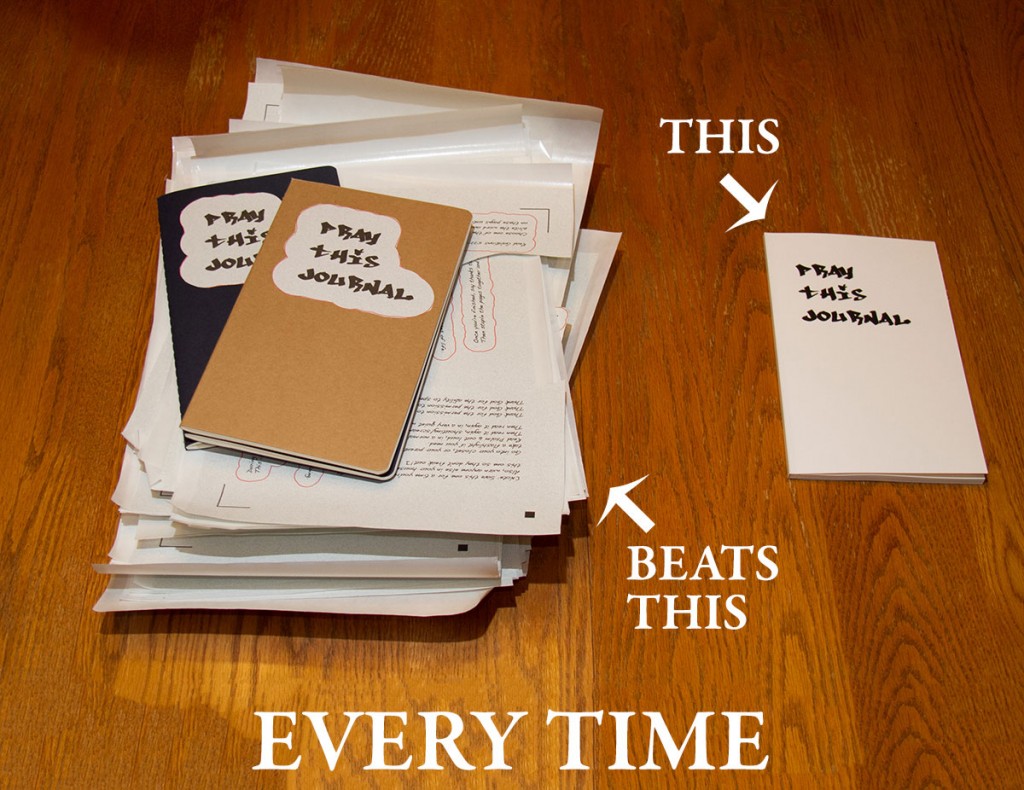Disciples pray a lot — but not often in a structured, prompted way. Episcopalians, however, love their structure. They created the Book of Common Prayer. They love the script; they love letting their souls assent to the written words. They put the prayers into their own voice.
So in May my co-teachers and I led a “lock-in” retreat for our 8-12 year old Sunday School class. 8 pre-teens, 4 adults — nothing could go wrong, right?
Well, to start with … a lock-in isn’t just a fun, run-around, open game night in our church. It’s like Sunday School Boot Camp … (but still fun!). We do different themes each year. I’m pretty sure two years ago was “faith.” Last year was “living like monks.” This year: “prayer.”
So what better way to show Episcopalian youth to pray than to create a new “prayer book” for them?
I modeled it off of the creative Wreck This Journal device. The journal’s helpful for finding new, innovative methods to mess with texts. I highly recommend it if you ever feel like you’re in a rut. It gives you lots to do. But as a prayer prompter — it needed a little tweaking.
And that’s where it went wrong …
One of my co-teachers is a crafting explorer. She’s claimed a super-majority of her basement for her scrapbooking enterprise. She values memories. And she values creating things by hand.
Her idea for creating our journals: she had an awesome adhesive tool that rolled the printed page onto sticker-material. Combine that with her digital cutter that cut custom vector shapes and it looked like we had a great solution. The kids would each get an 80-page prayer prompt journal and each would have a custom sticker for that day’s prayer prompt.
It was an awesome idea until you factored how much each person’s time was worth. The adhesive was mostly reliable. But when the margins of the print got a little off, and the digital cutter started bisecting prayers — at that point, it was no longer sustainable. Each prayer needed cut by hand. To the point that it would take each person about 2 hours to cut and paste each youth’s prayer journal.
The arts-and-crafts approach would have been great for the personal touch; for production, however, we needed something simpler.
Enter Blurb.
If you have a passing familiarity with graphic design or desktop publishing then Blurb will be a natural next step. It’s a simple, upload-print-bind operation that gives super-reasonable prices. In the end, the 74-page bound booklet was $6.95 on Blurb; even without for the personnel time (each person’s hourly rate) for the stickers, it would have cost over $11 per booklet to produce them by hand.
I’m thankful for my co-teachers for the patience and willingness to try. I’m thankful for Blurb for providing a professional solution. I’m thankful to be in a church that will spend this kind of money on a one-of-a-kind gift for their youth. Most importantly, I’m thankful God put these youth in our care. They bless our church so often.
































